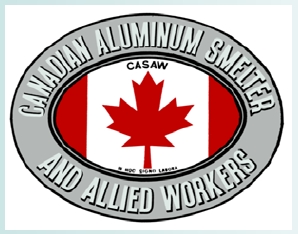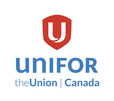Our Proud History
The following is only a summary of our local's colourful history.
For a more detailed account of the early years and formation of C.A.S.A.W., Check out C.A.S.A.W. HISTORY, THE EARLY DAYS by Klaus Mueller Sr. Helen's Cafe Mural Click here to view a 98k colour image of the P. Hopkins 1957 painting, commonly referred to as the "Helen's Cafe Mural", depicting the construction of Alcan's Kitimat & Kemano Project. The mural is on permanent display in the Unifor Local 2301 Union Hall as tribute to the accomplishment of workers.
THE EARLY YEARS 1954 - 1970
The first Unions certified at the Alcan complex in 1954 consisted of the Aluminum Workers International Union and nine separate building trade unions each with separate certifications. In 1956 the United Steelworkers of America International Union raided the Aluminum Workers Union and the building trades and became the sole certified bargaining agent for all Alcan workers in Northwest B.C. During the period 1956 to 1970, the Steelworkers Union gradually turned into a dues collecting agency. Alcan workers paid monies to a bank account in the U.S.A. and saw little in return in terms of membership benefits and service. In the latter years, our collective agreements were no longer considered the best in the province, as they once had been. There were many reasons for workers' dissatisfaction with their union. One final event triggered outright rebellion and defiance of the American appointed business agents and trustees. The three and a half month legal strike in 1970 which saw Alcan and the Steelworkers basically co-operate in the closure of the plant while keeping Kemano operating, then at the convenience of the company, settle the strike for no gain to the workers. Thus started the beginning of the end of the Steelworkers in Kitimat and Kemano.
The C.A.S.A.W. YEARS 1972 - 1994
During 1970 - 1972 the workers in Kitimat were almost continually under trusteeship by the American labour bosses and their lackey appointees. Seven CASAW (not yet certified) activists were charged under the Steelworkers constitution, then tried without a hearing in Washington, D.C. All received Union discipline. The Alcan workers rebelled, revoked all sanctions and began the serious drive to oust the ineffective, American Union. The main reasons for the formation of CASAW were local autonomy, financial control of union dues, Nationalism, dissatisfaction with Steelworkers representation, a series of inferior contracts, manipulated and lost strike in 1970, imposition of trusteeship, and disregard by the Union of membership desires and directives. After an unsuccessful attempt in 1971, the B.C. Labour Relations Board finally granted a representation vote in October 1972. The results were historic and decisive - 1,112 for CASAW - 305 for Steel. And so ended 16 years of domination of Kitimat - Kemano workers by the American Steelworkers. After certification in October, 1972, CASAW elected their first executive and began preparing for the task of negotiating the first contract under the Canadian Association of Smelter and Allied Workers banner. In conjunction, CASAW then affiliated with a fringe Central Labour body, the Canadian Confederation of Unions (CCU) whose stated mandate was to provide Canadian unions for Canadian workers. 1975 saw the beginning of the wage and price controls which were implemented in the middle of negotiations between CASAW and Alcan. This resulted in a lockout by the employer during November, 1975. The lockout was short-lived as the union sought and was successful in achieving a cooling-off period with a negotiated settlement with Alcan finally achieved. Significant labour/management problems surfaced in 1976. This led to an eighteen-day wildcat strike to protest the unscrupulous management tactics and the wage and price controls in effect. The strike began June 3 and ended June 21 with the president breaking a tie vote. CASAW was taken to task by Alcan and was sued for over $1 million with severe discipline handed down to over 200 activists who participated in or led the strike. The Quebec Union, the FSSA (Federation Des Syndicats Du Secteur Aluminium Inc.) workers in the Alcan eastern smelters were also on strike and sent a delegation of support for the Kitimat workers. This was the beginning of a long formalized relationship between CASAW and the FSSA which culminated in the forming of the Aluminium Workers Association and, finally, a Mutual Defence Pact. In 1978, a group of gold miners in Yellowknife, NWT wanted to join a Canadian union. CASAW signed the majority into their membership. Shortly thereafter, CASAW negotiated a historical contract in the mining industry on behalf of the workers in Yellowknife. It took a three-month strike before the settlement was reached. In 1978, CASAW utilized their own funds to conduct a health study, spearheaded by Dr. Carnow. This study, while not accepted by the medical association and Alcan, was the impetuous for further studies by having identified the smelting process as being conducive to industrial diseases affecting the lungs, bladder, etc. In 1980, CASAW negotiated a contract which truly indicated they were a bona-fide union to be reckoned with. During the mid-1970s, several health studies were conducted which confirmed lung, respiratory, and bladder problems as having a legitimate correlation with the aluminium smelting process. As a result, bladder cancer was put on Schedule "B" of the B.C. Workers' compensation list signifying that bladder cancer was a disease caused by the smelting process. During the 1980s and early 1990s, CASAW continued to prosper on behalf of its' membership. In 1991, CASAW, on request of the workers at the Alcan plant in Richmond, B.C., raided the United Steelworkers and became the certified representatives for 120 workers in this plant. In November, 1991 a new owner, an American, Peggy Witte, purchased the Giant Mine in Yellowknife, NWT. As a result of Peggy Witte's hard-line bargaining tactics and her insistence for across-the-board cutbacks, a historical strike/lockout ensued in May, 1992 and lasted until November, 1993 cumulating with the deaths of nine miners as a result of an explosion. A member of the local union in Yellowknife was charged and found guilty of the above mentioned deaths. Also in 1992, the workers at the Alcan Extrusion Plant in Richmond, B.C. struck the employer, in what was to be a seven-month strike, with the final outcome being the employer closing the facility down permanently.
Canadian Auto Workers 1994 - 2013
It was in 1994 that the membership of CASAW decided to dissolve their union and merge with the Canadian Auto Workers. This was done in recognition of the hardships imposed on the union through their horrendous struggles against Alcan and Giant Mines. It was felt by the leadership and supported by the membership that the CAW offered an opportunity to be part of a progressive, militant growing Canadian Union. The vote was 76% in favour with the merger being completed on July 1, 1994.
The Birth of UNIFOR 2013 - Present
Unifor was officially formed on August 31, 2013, at a Founding Convention in Toronto, Ontario. It marked the coming together of the Canadian Auto Workers union (CAW) and the Communications, Energy and Paperworkers Union of Canada (CEP) – two of Canada’s largest and most influential labour unions. The birth of Unifor represented a sign of hope for the Canadian labour movement, and working people more generally.
For a more detailed account of the early years and formation of C.A.S.A.W., Check out C.A.S.A.W. HISTORY, THE EARLY DAYS by Klaus Mueller Sr. Helen's Cafe Mural Click here to view a 98k colour image of the P. Hopkins 1957 painting, commonly referred to as the "Helen's Cafe Mural", depicting the construction of Alcan's Kitimat & Kemano Project. The mural is on permanent display in the Unifor Local 2301 Union Hall as tribute to the accomplishment of workers.
THE EARLY YEARS 1954 - 1970
The first Unions certified at the Alcan complex in 1954 consisted of the Aluminum Workers International Union and nine separate building trade unions each with separate certifications. In 1956 the United Steelworkers of America International Union raided the Aluminum Workers Union and the building trades and became the sole certified bargaining agent for all Alcan workers in Northwest B.C. During the period 1956 to 1970, the Steelworkers Union gradually turned into a dues collecting agency. Alcan workers paid monies to a bank account in the U.S.A. and saw little in return in terms of membership benefits and service. In the latter years, our collective agreements were no longer considered the best in the province, as they once had been. There were many reasons for workers' dissatisfaction with their union. One final event triggered outright rebellion and defiance of the American appointed business agents and trustees. The three and a half month legal strike in 1970 which saw Alcan and the Steelworkers basically co-operate in the closure of the plant while keeping Kemano operating, then at the convenience of the company, settle the strike for no gain to the workers. Thus started the beginning of the end of the Steelworkers in Kitimat and Kemano.
The C.A.S.A.W. YEARS 1972 - 1994
During 1970 - 1972 the workers in Kitimat were almost continually under trusteeship by the American labour bosses and their lackey appointees. Seven CASAW (not yet certified) activists were charged under the Steelworkers constitution, then tried without a hearing in Washington, D.C. All received Union discipline. The Alcan workers rebelled, revoked all sanctions and began the serious drive to oust the ineffective, American Union. The main reasons for the formation of CASAW were local autonomy, financial control of union dues, Nationalism, dissatisfaction with Steelworkers representation, a series of inferior contracts, manipulated and lost strike in 1970, imposition of trusteeship, and disregard by the Union of membership desires and directives. After an unsuccessful attempt in 1971, the B.C. Labour Relations Board finally granted a representation vote in October 1972. The results were historic and decisive - 1,112 for CASAW - 305 for Steel. And so ended 16 years of domination of Kitimat - Kemano workers by the American Steelworkers. After certification in October, 1972, CASAW elected their first executive and began preparing for the task of negotiating the first contract under the Canadian Association of Smelter and Allied Workers banner. In conjunction, CASAW then affiliated with a fringe Central Labour body, the Canadian Confederation of Unions (CCU) whose stated mandate was to provide Canadian unions for Canadian workers. 1975 saw the beginning of the wage and price controls which were implemented in the middle of negotiations between CASAW and Alcan. This resulted in a lockout by the employer during November, 1975. The lockout was short-lived as the union sought and was successful in achieving a cooling-off period with a negotiated settlement with Alcan finally achieved. Significant labour/management problems surfaced in 1976. This led to an eighteen-day wildcat strike to protest the unscrupulous management tactics and the wage and price controls in effect. The strike began June 3 and ended June 21 with the president breaking a tie vote. CASAW was taken to task by Alcan and was sued for over $1 million with severe discipline handed down to over 200 activists who participated in or led the strike. The Quebec Union, the FSSA (Federation Des Syndicats Du Secteur Aluminium Inc.) workers in the Alcan eastern smelters were also on strike and sent a delegation of support for the Kitimat workers. This was the beginning of a long formalized relationship between CASAW and the FSSA which culminated in the forming of the Aluminium Workers Association and, finally, a Mutual Defence Pact. In 1978, a group of gold miners in Yellowknife, NWT wanted to join a Canadian union. CASAW signed the majority into their membership. Shortly thereafter, CASAW negotiated a historical contract in the mining industry on behalf of the workers in Yellowknife. It took a three-month strike before the settlement was reached. In 1978, CASAW utilized their own funds to conduct a health study, spearheaded by Dr. Carnow. This study, while not accepted by the medical association and Alcan, was the impetuous for further studies by having identified the smelting process as being conducive to industrial diseases affecting the lungs, bladder, etc. In 1980, CASAW negotiated a contract which truly indicated they were a bona-fide union to be reckoned with. During the mid-1970s, several health studies were conducted which confirmed lung, respiratory, and bladder problems as having a legitimate correlation with the aluminium smelting process. As a result, bladder cancer was put on Schedule "B" of the B.C. Workers' compensation list signifying that bladder cancer was a disease caused by the smelting process. During the 1980s and early 1990s, CASAW continued to prosper on behalf of its' membership. In 1991, CASAW, on request of the workers at the Alcan plant in Richmond, B.C., raided the United Steelworkers and became the certified representatives for 120 workers in this plant. In November, 1991 a new owner, an American, Peggy Witte, purchased the Giant Mine in Yellowknife, NWT. As a result of Peggy Witte's hard-line bargaining tactics and her insistence for across-the-board cutbacks, a historical strike/lockout ensued in May, 1992 and lasted until November, 1993 cumulating with the deaths of nine miners as a result of an explosion. A member of the local union in Yellowknife was charged and found guilty of the above mentioned deaths. Also in 1992, the workers at the Alcan Extrusion Plant in Richmond, B.C. struck the employer, in what was to be a seven-month strike, with the final outcome being the employer closing the facility down permanently.
Canadian Auto Workers 1994 - 2013
It was in 1994 that the membership of CASAW decided to dissolve their union and merge with the Canadian Auto Workers. This was done in recognition of the hardships imposed on the union through their horrendous struggles against Alcan and Giant Mines. It was felt by the leadership and supported by the membership that the CAW offered an opportunity to be part of a progressive, militant growing Canadian Union. The vote was 76% in favour with the merger being completed on July 1, 1994.
The Birth of UNIFOR 2013 - Present
Unifor was officially formed on August 31, 2013, at a Founding Convention in Toronto, Ontario. It marked the coming together of the Canadian Auto Workers union (CAW) and the Communications, Energy and Paperworkers Union of Canada (CEP) – two of Canada’s largest and most influential labour unions. The birth of Unifor represented a sign of hope for the Canadian labour movement, and working people more generally.
HISTORY PROJECT
| |||||||


